

Let me get something straight from the get go…
A well-constructed content strategy alone is NOT going to guarantee you results.
As Wells Fargo CEO John Stumpf famously said: “We could leave our strategic plan on an airplane, somebody could pick it up, and it wouldn’t matter. It’s all about execution. It’s how you hire… how you inspire.”
That sentiment, whilst contextually relevant to the strategic direction of a multi-national corporation, rings true for any small business trying to win at content marketing.
With the endless amount of information available online, for free, to ALL of your competitors… Your plan doesn’t really matter that much.
Nothing you dream up is going to be significantly unique any more. It’s probably been done before.
But that’s only half the story…
The reality is that only 30% of organizations consider themselves effective at content marketing.
However, marketers that document a content strategy are considered more effective than those that don’t.
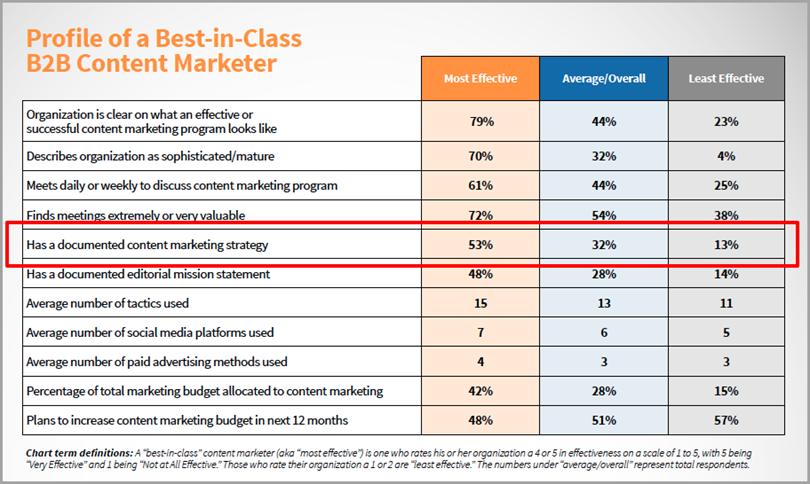
The takeaway? You need a content strategy if you’re going to be the MOST effective content marketer you can be.
How to Create an Effective Content Strategy
This is not just a blogging strategy, a social media strategy, an SEO strategy, or an email marketing strategy… Because content marketing needs to be all of those things.
Effective content marketing brings together the best tools, tactics and strategies in online marketing and it delivers you high quality leads time and time again.
A well-put together content strategy looks at the entire journey of your customer from stranger to premium recurring client, and all the bits in-between that influence that journey.
Below I’ve provided a table of contents to help you navigate this article, I recommend going from start to finish in order, but feel free to jump to the parts that are most pressing for you right now.
Contents
Purpose, Goals and Measurement
Content Planning and Management
Marketing Funnels and Lead Nurturing
Purpose, Goals and Measurement
The first step to building an effective content strategy is to identify the goals of your business. That’s right, your “business”… not just your blog.
Knowing what your goals are can help you turn them into something quantifiable and measurable. It helps guide your content marketing decisions and keep things on track.
If you don’t have something to work towards, and a way to measure it… Then you’ll never know if you are succeeding.
Here is an example set of goals that I have used on a content marketing strategy for a client:
Primary Goal: Build a brand of authority in 12 months
Secondary Goals: Define what “Authority” looks like
- Grow monthly traffic to 20,000 visitors
- Get 500+ social shares and 10 comments per blog post
- Build email list to 15,000 people
- Increase email open rates to 30%, and click throughs to 15%
- Grow customer base by 10%
Do you see how each of these goals is quantifiable and time bound? The more specific and measurable your goals can be, the more chance you have of pursuing them with your content strategy.
The metrics you track then become a way to systematically move towards these greater goals. Because they set a baseline, and help you make decisions on priorities and focus over time.
These metrics typically fall into three buckets:
- Traffic (Organic, Referral, Social, Direct, Paid, Other)
- Engagement (Time on site, social shares, comments, inbound links, email open rate & click through rate)
- Leads & Growth (Email subscribers, enquiries, webinar signups, customers)
This is what the metrics dashboard looked like in the above example before tracking analytics:
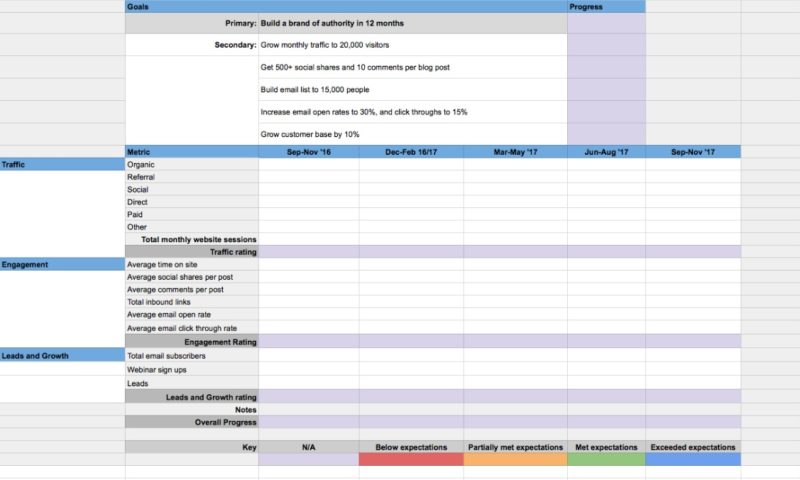
Here are some other interesting resources about content marketing goal setting and measuring success:
15 Blog Metrics That Will Track What You Actually Care About – Blogger Sidekick
Content Marketing Goals You Should Have – Search Engine Journal
5 Ways to Translate Your Content Marketing Goals into KPIs – Content Marketing Institute
Research
A lot of marketers want to jump straight into the “strategy” development… (Basically an aimless brainstorming session that makes them feel like they planned something)
Without an appropriate amount of research, coming up with a strategy is just guesswork.
By taking the time to research your audience, keywords, influencers and opportunities to expand your brand’s reach, you will increase your chance of success.
Buyer Personas and the Customer Journey
A buyer persona is a representation of what you believe your ideal customer to be. You should build this using real data about your current customers and market research.
Having a clearly defined buyer persona will help you understand your audience’s needs, goals and interests.
In fact, websites that market to personas are 2-5 times more effective than those that have generalist copy.
You should use these buyer personas to create a content strategy that helps guide your customers along a journey through awareness, research and finally to purchase decision.
Below is a graphical representation of a buyer persona template:
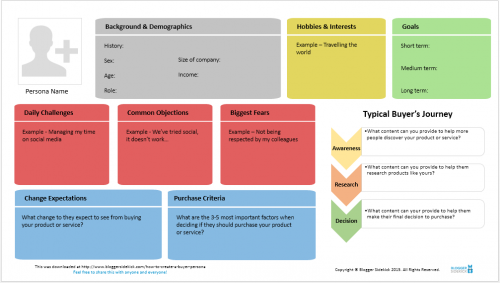
For more information on this part of the strategy, here’s a detailed guide on creating a buyer persona:
How to Create a Buyer Persona for Your Blog – Blogger Sidekick
Keyword Research
Blogging and content marketing have a lot of benefits for SEO:

But ranking well in search isn’t as important as ranking for the right reasons.
By conducting in-depth keyword research you can unlock relevant search terms to target with your content strategy.
There are a lot of different keyword research methods you can use, here are 35 of them:
35+ Keyword Research Methods To Unlock Hidden Gems – Blogger Sidekick
Content opportunities
Content opportunities are when a topic, or search term, has the following:
- Decent search volume, to make it worthwhile
- Underdone or outdated content, that you can improve on
- The other content has a nice level of engagement and links, despite it generally being below average
If you can find some red-hot content opportunities, and create quality content to fulfil the exact user intent of these searches, the search rankings will be much easier to get.
Influencers
The research phase of your content strategy development should also discover relevant influencers in your industry.
What is an influencer?
An influencer is someone who can get your content in front of more of the right people.
The reality is that 92 percent of people trust recommendations from individuals (even if they don’t know them) over brands.
Influencers can help you by:
- Sharing your content on social media to an already engaged and large following
- Backlinking to your content from credible websites they own or contribute to
- Introducing you to other industry leaders
Here are some resources to get started with influencer research:
The Complete Guide to Influencer Marketing – Content Marketing Institute
7 Powerful Influencer Research Tools That Get Fantastic Results – Blogging Wizard
Content Planning & Management
Have you ever turned up to a company’s blog and noticed that the latest post was from 2014?
Their credibility immediately plummets.
If you can’t maintain consistency with your marketing then you are better off not doing it at all.
And this desire for more content is present in the content strategies of businesses all over the world.
In 2016, over 75% of content marketers had plans to create even more content than they did in 2015:
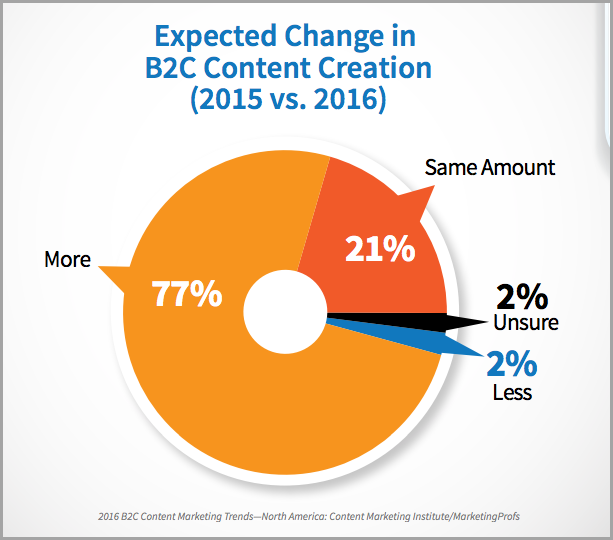
The more content you create, the more emphasis needs to be put on the “not-so-sexy” planning and management aspects of your content strategy.
Editorial Schedule
Your content strategy needs to be partnered with an editorial schedule or calendar.
At this juncture, the MOST important thing is looking ahead and staying consistent. I don’t care if you only plan to blog once a month, but lock it in and stick to that schedule.
The content rhythm I recommend to a majority of our clients is as follows:
- 1 piece of anchor content every month (2,000+ words)
- 3 smaller blog posts every other week (800-1,200 words)
We’ve found that for most small businesses this run rate is sustainable, and it also delivers the outcomes they are looking for.
I’ll talk more about what the difference between anchor content and a regular blog post is in the “Content Creation” section of this article.
To keep everything on track you should put your content ideas for the next 3-6 months in an editorial calendar.
For some of you, a spreadsheet will be enough. But for others you may want to make the most of the calendar tools available such as WordPress Editorial Calendar or CoSchedule.
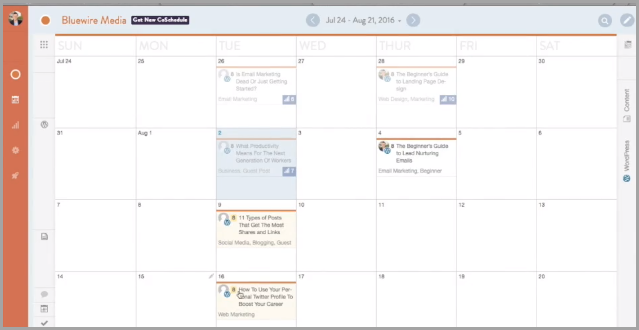
Accountability and motivating contributors
An important element for building a backlog of consistent blog content is ensuring your contributors are accountable.
Whether you are writing all the content yourself, getting ghost writers, hiring a full-time content marketer, or enlisting an agency… They need to be accountable to the schedule you set.
Here are some helpful ways to motivate internal contributors:
13 Ways to Effectively Motivate Your Team of Internal Blog Contributors – Blogger Sidekick.
Identifying obstacles and removing them
Creating consistent content is a major challenge for content marketers, because it can be so time consuming to ensure that quality standards are met.
If you don’t tackle the problem head on, you could end up with a blog that hasn’t been updated in months.
Here are some tips on how to remove these obstacles and stay on track:
23 Ways Create Consistent Content Among 101 Other Priorities – Blogger Sidekick
Content Creation
There’s a lot more to an effective content strategy than just writing and publishing blog posts.
You need to create different types of content to complement, re-enforce and extend your written content.

All the content you create needs to be optimized to meet the needs of your audience and the requirements of the platforms you promote it on. They also must be optimized to drive your business objectives.
For the purpose of this section we are predominantly talking about the written content on your website… However, your written content should be accompanied by other forms of media such as video, images, graphics and more.
Content Anchors
Many content marketers make the mistake of thinking that a few 500-word posts per week will be enough to reach your audience.
That kind of content might get clicks on social media, but it’s difficult to rank in search. And with so many other websites already doing the same, it will be even harder to stand out and make a difference.
Google is favoring comprehensive, long-form content over short pieces that just brush the surface…
And longer form content gets shared more on social media:
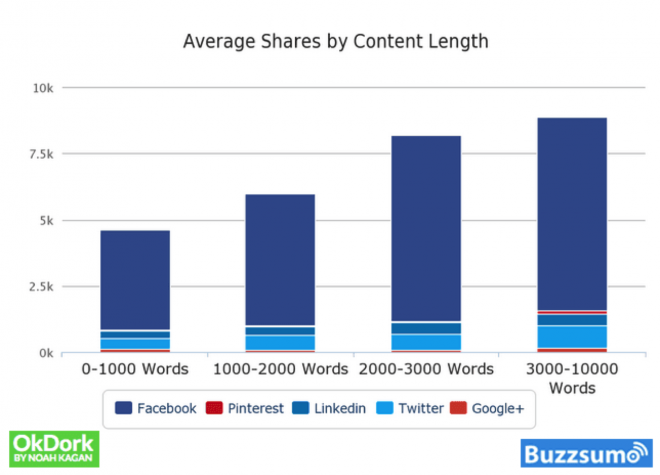
That’s why you need to invest some time into creating “anchor content” – a comprehensive resource that’s better than everything else out there on your chosen topic. Not just better, but 10x better than anything else out there.
Content Anchors form the cornerstones of your content strategy, are optimized for high-volume search terms, and are on topics that your customers ACTUALLY care about.
You should aim to have a content anchor for each of your core blog categories.
If you want to learn more about what a content anchor is, read this article:
What is a content anchor? – Blogger Sidekick
Blog posts
Content anchors establish structure for your efforts and help you understand what topics are most important to your customers.
Regular blog posts then act to support these content anchors and build on the key points you make in them.
They keep a steady rhythm going on your website and make sure it is always updated with fresh content. They also help you diversify your content strategy with case studies, reviews, audits, expert interviews, video content, presentations, mini-list posts, trending news… and just about anything else you can think of.
If you link between your blog posts and the content anchors in the same topic area, it creates a healthy internal link structure, which is beneficial to your SEO efforts over time.
Suggesting related posts within your content can also help keep people on your site for longer and move them down the sales funnel.
How to create great content
It’s all very well to understand the TYPE of content you should create, but producing the kind of content that engages your audience time and time again is even more important for your strategy to succeed.
According to the Content Marketing Institute, this is the biggest challenge for content marketers:
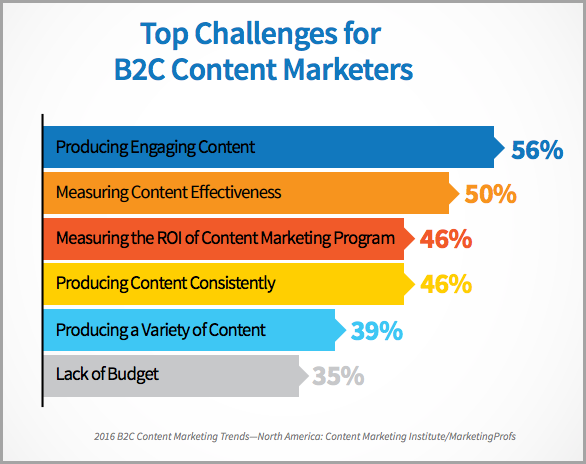
Here are some resources that will help you create better content in less time:
11 Principles for Writing the Perfect Blog Introduction – Blogger Sidekick
How to Write Blog Content Like a Boss – Blogger Sidekick
Write Quality Content Quicker With The Content Booster Hack – Blogger Sidekick
Optimization
When I talk about “Optimization” in terms of content creation, it’s all about preparing your content to get more shares, more engagement and a better return for your business.
Optimized content sits somewhere in the sweet spot between SEO, social media and influencer marketing.
It’s all the factors you need to consider before you hit publish on a blog post to ensure that it is going to perform at its full potential.
When it comes to creating a content strategy for your business, this means you need a checklist, some guidelines or a style guide for your content efforts that is the best practice for everyone to follow.
This bundle has a content checklist that may be helpful:
SEO Content Bundle – Blogger Sidekick
SEO Optimization
As I mentioned in the keyword research section of this article, SEO is one of the primary reasons people create content regularly…
Why?
Because search engine traffic still dominates any other source of website traffic in terms of volume.
Google likes fresh content, and they favor websites with longstanding credibility across a lot of high quality indexed pages.
The quickest and most effective way to deliver Google what they want is by optimizing your site and content strategy with best practice SEO.
Basecamp
The SEO content strategy we developed here at Blogger Sidekick is called the SEO Spider’s Web.
At the core of the web is your “Basecamp”. Essentially your basecamp is a page on your website that helps visitors navigate to the MOST important information on your site.
It guides users around and helps reduce confusion and information overload, as well as getting more visibility for your best content.
Perry Belcher from Digital Marketer uses a similar strategy for whenever they set up a new niche site, they call it the “Fishbone.”
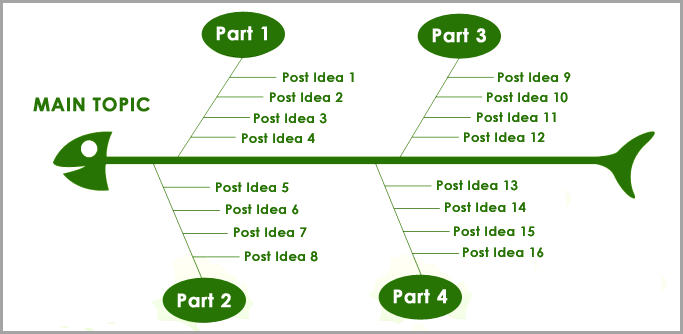
Need an example of a basecamp/fishbone page? You’re looking at one right now.
This content strategy resource is designed to be our new basecamp… Because it lays the foundation for everything else that Blogger Sidekick stands for.
For more information on the SEO Spider’s Web and setting up your basecamp, read this article:
Revealed: The Secret SEO Strategy No One Is Talking About – Blogger Sidekick
Spin your web
Despite some mixed opinions on the topic, anchor text still makes a difference for SEO.
Google looks at the text used with your hyperlinks to determine the relevance of a link. Of course, if the text looks unnatural ALL of the time, it sends off alarm bells and you can get penalized.
When you create links between the pages on your site, you need to make sure the text is relevant. And that’s exactly what you should be doing…
If you create a new blog post and it is contextually relevant to another important page on your website, then you should find an appropriate piece of text in that blog post to link to that other page.
Your anchor text optimization strategy is called “Spinning your web”.
On-page elements
At the end of the day, you can’t forget that Google is a robot…
That’s why on-page SEO optimization is still important.
Optimizing your body content with keywords is only one piece of the on-page SEO puzzle.
Meta tags, headers, images, alt tags and more can all be optimized to increase your page’s relevance in search.
Here is a graphic representation of what I’m talking about:
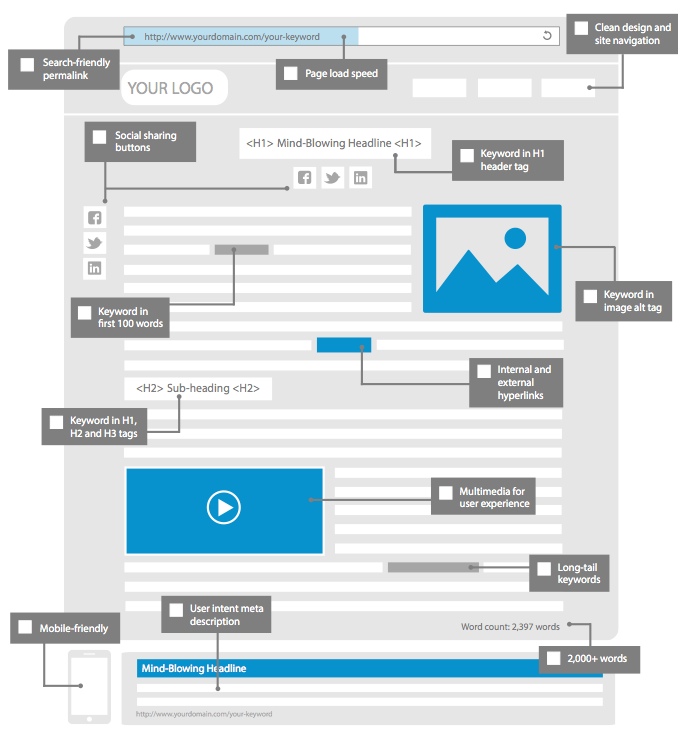
Download the above checklist as part of this bundle:
SEO Content Bundle – Blogger Sidekick
Conversion
Whatever strategies you use to create content for your blog and promote it, they all share the same underlying goal – conversions on your website.
Basically a conversion is when someone who lands on your website takes the specific action that you want them to, usually giving up their contact information in exchange for something of value. Businesses that adopt content marketing see conversion rates nearly 6x higher than those who don’t.
Let’s take a look at the essential elements of your content strategy that make this happen:
Web design
Given 15 minutes to consume content, two-thirds of people would rather read something beautifully designed than something plain, according to Adobe.
Effective web design that is congruent with your brand and helps visitors make easy decisions, can significantly influence conversions.
So even if your content is great, your web design needs to be optimized for your audience as well.
Here’s a guide that covers the most important design elements of your blog:
The Ultimate Guide to Effective Blog Design – Blogger Sidekick
List building
It’s unlikely that you will get a positive return on your content marketing efforts if you don’t integrate email into your strategy.
I’ll talk more about email nurturing later in the article, but when it comes to conversions your goal should be to turn as many web visitors as possible into email subscribers.
You do this by optimizing your whole site for email capture, and using popups and squeeze pages to improve your results.
Just like Ramit Sethi does here:
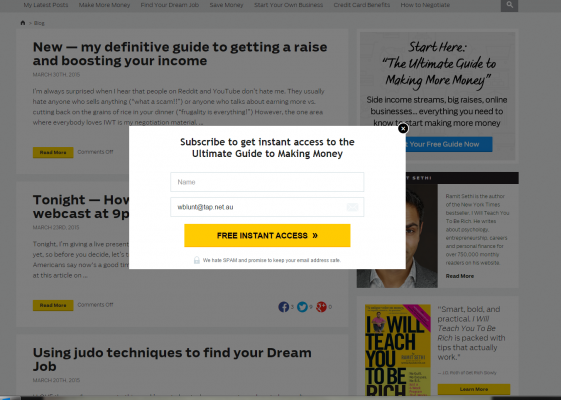
Here is some further reading on optimizing your site and building a big email list:
List Building – Get More Email Subscribers Than You Can Handle – Blogger Sidekick
10 Best Popup WordPress Plugins To Convert More Subscribers – Blogger Sidekick
11 Irresistible Elements of a Killer Squeeze Page – Blogger Sidekick
Lead magnets and offers
Lead magnets and content offers are tools and resources that your prospects can access from your site, in exchange for their contact information. You can then use this contact information to better market to them through targeted email campaigns.
One of the most effective ways to deliver lead magnets or offers to your prospects is by using content upgrades.
A content upgrade is a resource that is extremely relevant to one of your blog posts, but has a higher perceived value with your prospect.
Here is an example from Brian dean’s site Backlinko:
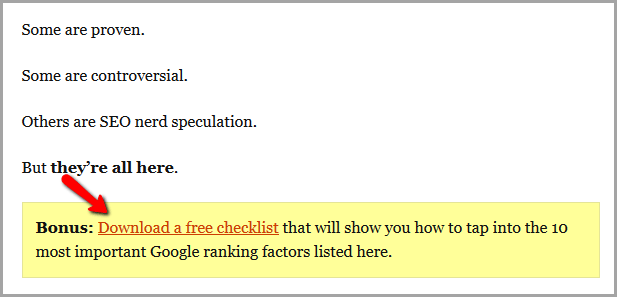
Brian Dean used this content upgrade to boost conversions on this page by 785% in one day.
Looking for some more lead magnet ideas? Here are 40 of them:
40 Lead Magnet Ideas to Rapidly Grow Your Email List – Blogger Sidekick
Relationships
Building relationships with influencers can help jumpstart your list growth in two ways:
- Guest blogging – You can reach out to influencers with a similar audience, contribute content to their site, and bring more leads directly to your business
- Lead magnet swap – This is when you share someone else’s lead magnet with your audience, and in exchange they share your lead magnet with theirs. It’s a great way to quickly grow your subscriber list, but requires a very strong relationship to execute.
Here’s an interesting resource about reaching out to influencers:
How To Reach Out To Influencers So That They Can’t Say No – Crazy Egg
Promotion
One of the biggest mistakes content marketers make is assuming that if they create great content, people will find it and consume it.
For every 85 cents that marketers spend on content creation, they only spend 15 cents to amplify that content. In my experience those figures should be flipped around if you want to see genuine results.
Promoting your content is more than just sending out a few tweets, it’s a systematic and repeatable process that delivers results every time you publish something.
If you’re looking to scale up your content promotion efforts, this article may help:
56 Ridiculously Effective Tactics For How To Promote Your Blog – Blogger Sidekick
Social Media
Social media is the most common content marketing delivery mechanism, used by 87% of marketers. In fact it’s where most people’s “promotion” efforts start, and stop.
This comic from Moz sums up the idea:
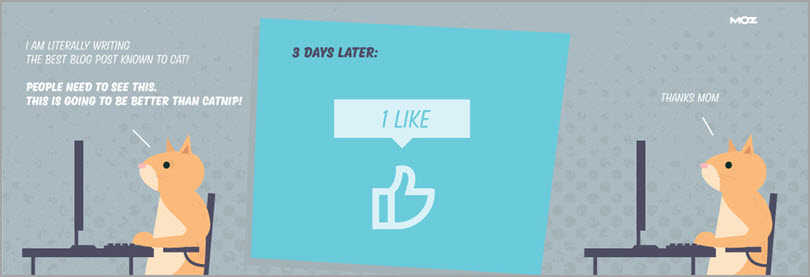
Don’t think that a few tweets here or there are going to be enough to get visibility for your content, social media can help you do so much more than that.
Here are some resources that will help you improve your social sharing when it comes to content promotion:
How to Easily Double Your Traffic from Social Media – KISSmetrics
Social Sharing: How to Get More People to Share Your Content – Social Media Examiner
How to Get More Traffic to Your Blog (Snap, Crackle and Pop) – Blogger Sidekick
Email is a great way to promote your content – after all, your subscriber list has already told you they care about what you have to say by opting in.
If you create a great piece of content, to get the most bang for your buck, send out a broadcast email and then integrate that email into your automation sequence.
This article is a good place to find out more about integrating email marketing with your content strategy:
12 Tips: How to Use Email to Drive Traffic to Your Blog – Wishpond
Outreach and influencer marketing
Influencer outreach can be a powerful way to promote your content. For example, when GNC adopted a strategy to reach out to influencers, they ended up adding 383,000 new Facebook fans as a result.
If you can find influencers willing to share your content with their email list, feature it on their blog, or share it on social media – the traffic will start pouring in.
For some tips on identifying influencers and effectively outreaching to them, read this article:
Everything You Need to Know About Blogger Outreach – Blogger Sidekick
Link building
Google revealed that high quality links are one of the top three factors it considers for ranking your content.
As a content marketer, you should consider search engines as an important platform to market your content and get people onto your website.
So if you create great content and market it the right way by effectively building backlinks, then you’ll start to generate organic traffic on autopilot.
The importance of content in contributing to the search engine performance of your website is continuing to grow:
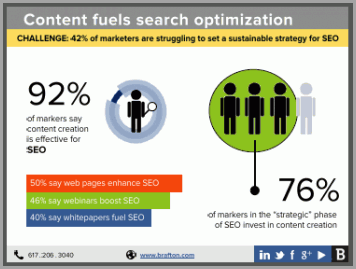
For more information on link building and leveraging content to rank in search, read this article:
How to Find People Who Will Backlink To Your Content – Blogger Sidekick
Community engagement
Another important promotion element of your content strategy is to make sure your content is part of relevant industry discussions and communities.
There are many platforms where you can engage with your community and promote your content at the same time:
- LinkedIn Groups
- Facebook Groups
- Google+ Communities
- Industry forums
- CoPromote
- Viral Content Buzz
If you use these platforms right, you can get serious reach for your content.
Guest blogging
Guest blogging is one of the most powerful ways to promote your site and it’s content, from an organic perspective. When I say “organic” it’s because you don’t technically need to pay any money to get exposure with guest blogging.
Some of the best startup stories of the last decade have been built on the back of guest blogging strategies, such as Buffer and Groove HQ.
For more information on the benefits of guest blogging and how you can use it to boost the visibility of your business, read these articles:
7 Benefits of Guest Blogging (Plus 2 Case Studies) – Blogger Sidekick
How to Guest Blog for List Growth – Blogger Sidekick
Paid media
Paid media promotion is a lot more accessible to content marketers today than ever before.
Platforms like Quuu Promote help you tap into social media influencer networks, and then you have services such as Outbrain where you can promote your content around the web on their group of influential websites. It can cost as little as $5 to get started.
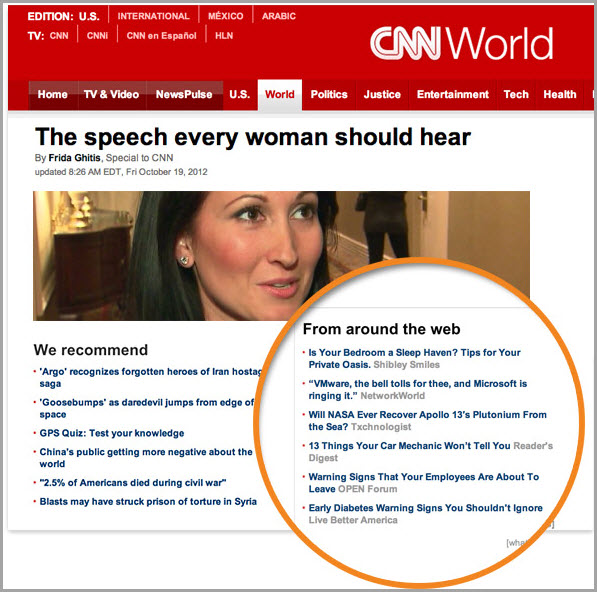
But if you have some money to spend on advertising your content, I’d recommend using Facebook ads. Their targeting is next level and if done well the cost-per-click is significantly lower than anything else I’ve tried.
Marketing Funnels & Lead Nurturing
A content strategy that doesn’t progress your business outcomes is NOT effective.
Everything you research, create, optimize and promote needs to contribute to the greater goals of your business, which are more often than not your bottom-line revenue and growth aspirations.
Nearly half of all marketers are learning to drive content to align with the buyer’s journey.
And the more you can position your content to match each lead’s unique needs on this journey, the better your chance of getting them to push further down the marketing funnel and eventually convert into a customer.
Product tiers
No matter what the product or service you offer, you can better communicate its benefits to your customers using product tiers.
“Product Tiers” are simply a way to segment your offers based on the perceived barrier (or cost) of someone consuming them.
The bottom of your tier starts with content, it’s free and gets people visibility of your business and exposes them to other offers.
The second tier is a lead magnet, where they will exchange contact information to access premium content.
From there, you systemically create more value, and charge more money, for every offer as your prospects make their way up the value ladder.
Bonus tip: Flip the value ladder and your product tiers upside down and it forms your marketing funnel.
Here’s a visual representation of the concept from Russell Brunson:
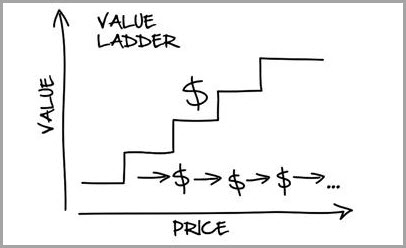
Looking for some further resources to help you get started on building your own product tiers? These are a good starting point:
The Value Ladder – DotCom Secrets Russell Brunson – YouTube
DotComSecrets Daily Sketch Episode 6 – YouTube
Tripwire offer
Your tripwire offer is a crucial part of your sales funnel – its sole purpose is to turn your prospect into a paying customer. It’s the first step above “Free Content” and your “Lead Magnet” in the value ladder.
Offering an irresistible tripwire offer can deliver serious ROI, because it’s estimated that once someone buys from you – regardless of the price – they are 10x more likely to buy from you again.
In one example, Authority Hacker sold part one of their video course for $9.95, and then up-sold their main offer to these tripwire buyers. They ended up with a 26% upsell rate, and $2,376 in core revenue from a small email list.

Check out part four of the below resource to learn how to create your own tripwire offers:
Customer Value Optimization: How to Build an Unstoppable Business – Digital Marketer
Email automation and evergreen funnels
According to Conductor, email marketing produces the highest quality leads for B2B companies. It also has a great ROI:
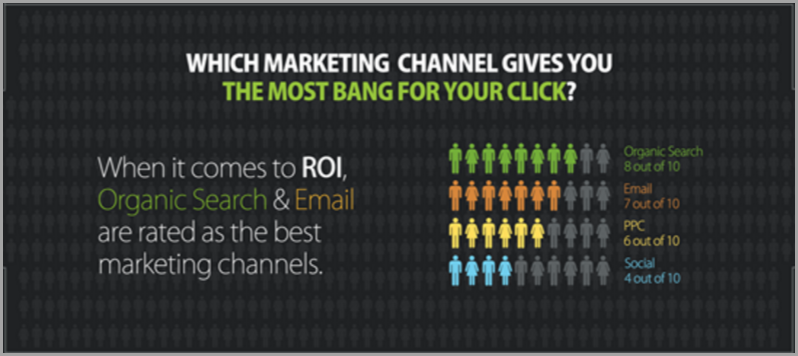
The idea of email automation and “evergreen” funnels is that you can build it once, and then spend your time trying to drive prospects into the top end.
An evergreen email funnel gives your prospects the right content to fit their position in the sales process, at the exact time they need it.
You can do this with the help of automated email trigger campaigns catered to the behavior of a prospect on your site, or the lead magnet they download. Software such as Infusionsoft, ActiveCampaign, and Ontraport make this possible.
Deadline Funnel is another great software for evergreen automation sequences, because it creates unique deadline offers for each and every lead… And we all know how powerful urgency is in the buying process.
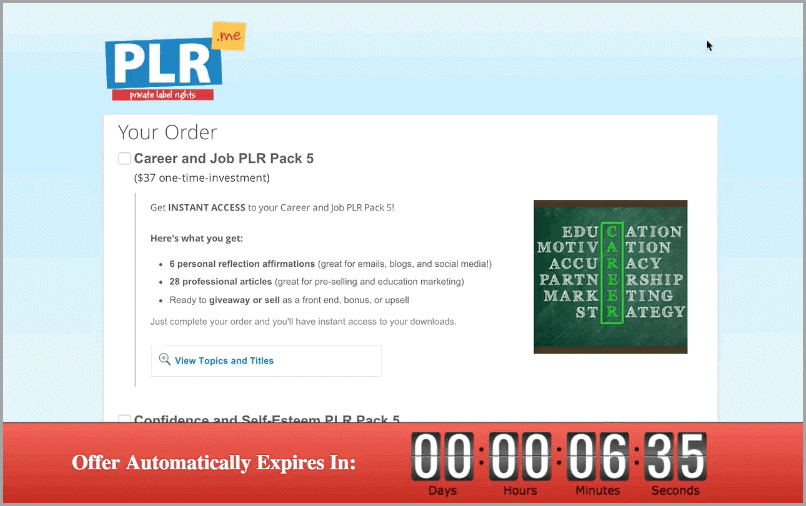
For a truly scalable business and supporting content strategy, evergreen email automation is essential.
Learn more about creating your own evergreen funnels with these resources:
Build Your 7-Figure Evergreen Machine – Summit Evergreen
Todd Brown’s Marketing Funnel Automation Blog
Webinars and rolling launches
Webinars are definitely popular, with 61% of B2B businesses using them in their content marketing strategy.
There is just something about a live event (albeit online) that convinces people to take action afterwards.
So when your webinars are partnered with an effective Facebook ads strategy, pre-event email sequence and an urgency-building post-webinar email sequence – they can make you a LOT of sales.
When it comes to your content strategy, webinars are a great way to take prospects from “on the fence”, to paying customer within a few days. So focus your top-of-the-funnel content on driving email signups, and then use tactics such as email automation and webinars to close more deals.
Where should you go if you want advice on running successful webinars? Amy Porterfield.
Scaling
Attempting to scale your marketing efforts, and your business, isn’t for everyone… Some of us are happy with what we’ve got, and are dedicated to simply maintaining it.
But for others… Growth is a major attraction.
The thing is, 70% of startups struggle with scalability.
So even if your sales funnel is tight and your content calendar is stocked and ready to fire, if you want to scale your business and your marketing efforts, it adds a lot of complexity.
At some point along the journey YOU personally won’t be able to write all of the blogs, or host all of the webinars, if you want to take things up a notch.
Here are your options for scaling up…
Outsourcing to specialists
Outsourcing content marketing is a common practice for brands. In fact, 64% of B2B marketers outsource writing.
The reason for such a high “outsource” rate is because many businesses have a talent gap:

Finding external specialists to help with your growth aspirations is the quickest way to scale in the short term, but of course it’s not easy to find the right people.
You don’t need to dive in head first and outsource everything, start with a few small tasks here and there. Then see what happens.
Here are some ideas:
27 Time-Sucking Blog Tasks You Can Outsource [Infographic] – Blogger Sidekick
Hiring a team
Hiring a team gives you more direct control over the execution of your content strategy – it makes aligning to your vision and core messaging a little easier.
In fact a lot of businesses use in-house staff for content marketing:
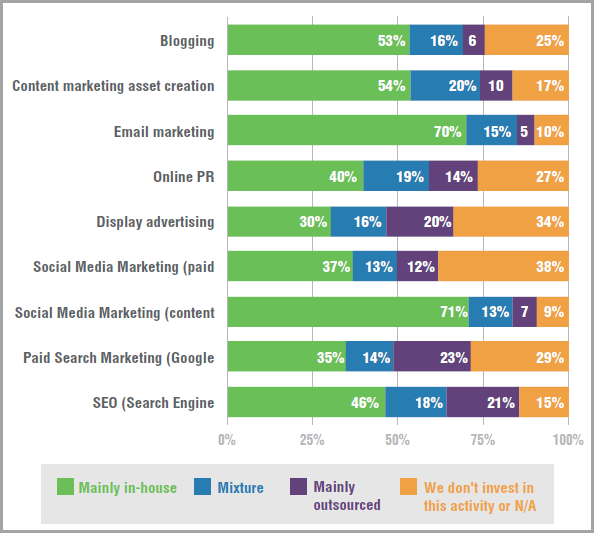
However, hiring a team can be riddled with risks. Poor hires, expensive payouts and long on-boarding processes to name a few.
One important role in a content marketing team is a blog manager, they are integral to the coordination of your whole strategy.
If you’re looking for an effective content manager; outsourced or in-house, here are some qualities to look for:
22 Qualities of a Mind-Blowing Blog Manager – Blogger Sidekick
Paid advertising
If your content strategy is humming along nicely and your marketing funnel is tight, then paid advertising can quickly take your business to the next level.
Paid advertising is almost mandatory to get reach on Facebook these days, because organic reach is falling. And it’s also important for search, since less than 10% of people go past the first page of results, and Google is taking up most of that real estate with ads.
For example, B2C content marketers use a wide variety of paid advertising methods to get exposure for their content, with “Promoted Posts” the most popular:
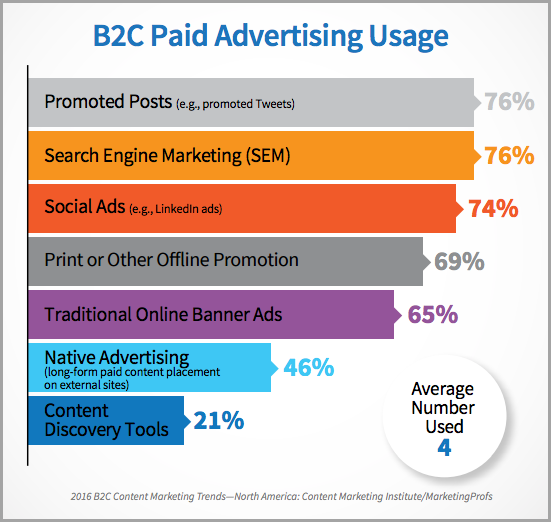
When you are developing your content strategy I would think about paid advertising this way…
- Use 70% of your ad budget to send prospects to content (blog posts)
- Use 25% of your ad budget to remarket to those who read the blog post above, targeting them with a relevant lead magnet and pushing them into your automated email sequence
- Use the final 5% of your ad budget to remarket to people whilst they are in your automation sequence, selling them a time bound offer of your product or service
Of course, this is just a guide. But if you can optimize each part of this marketing funnel your ability to scale becomes almost limitless.
Here are some resources to help you get started:
The Complete, Always-Updated Guide to Facebook Advertising – Buffer
Jon Loomer’s Blog for Advanced Facebook Marketers
Turn Your Failing Ads Around in Under 5 Minutes With These Simple FB Ad Optimization Tweaks – Andrew Hubbard
Conclusion
Content marketing certainly isn’t easy…
Actually, I would say it’s extremely hard. Which is why only a tiny group of businesses that try, ever really make a big splash.
The reality is, you can get results without focusing on everything I have outlined in this article. But you need to think of your online marketing tactics as a well-integrated machine, that are contributing to your business goals.
It’s not just about a blog. It’s not just about a few Facebook ads. You need it all working together as one.
Now you’ve got the pieces of the puzzle, you just need to put them into place in a way that makes the MOST sense for your business.
What is the very first thing YOU need to do, in order to get your content strategy on track?
